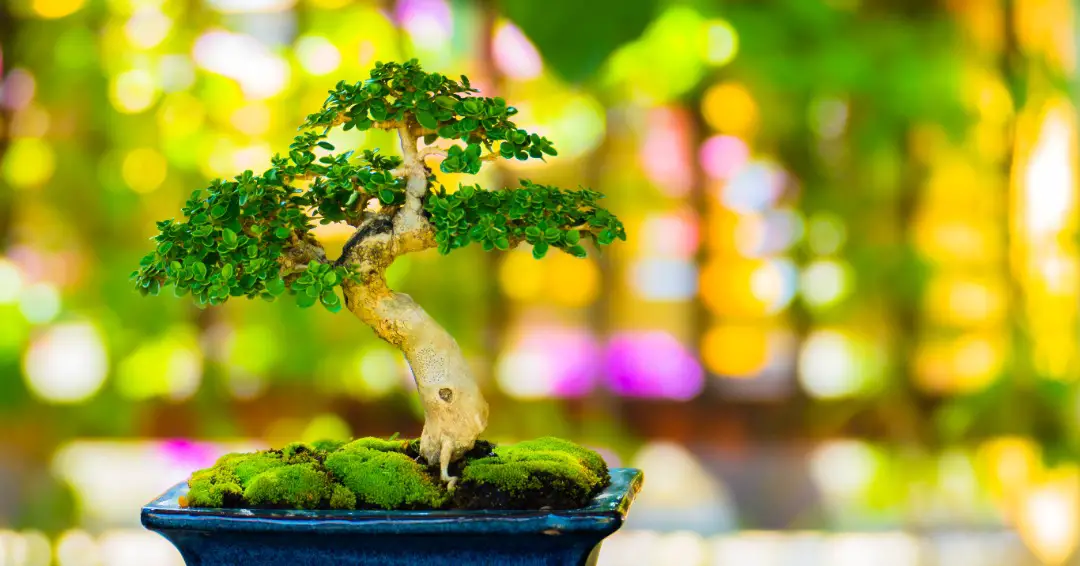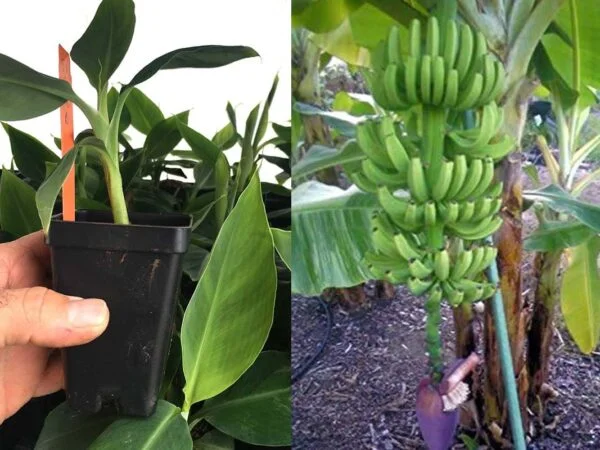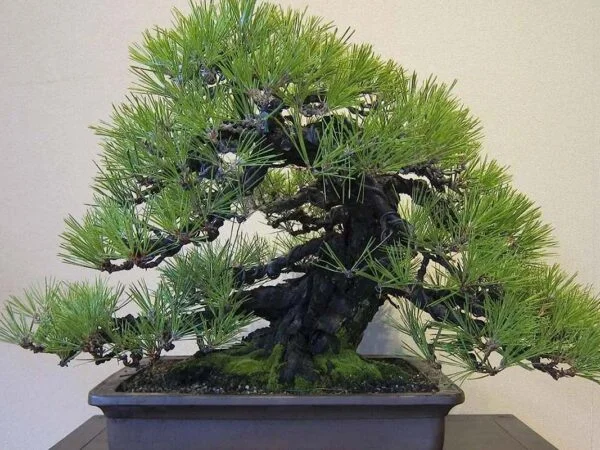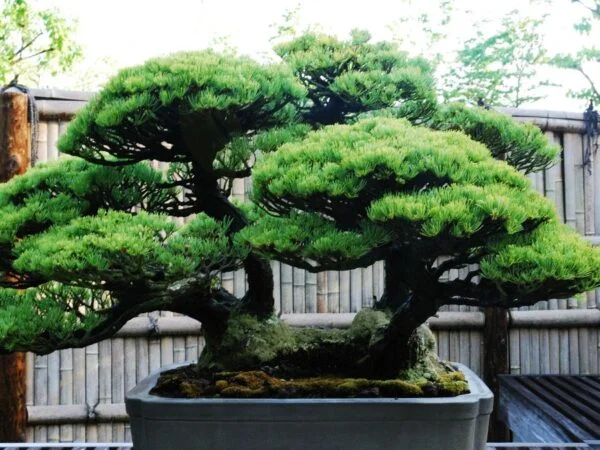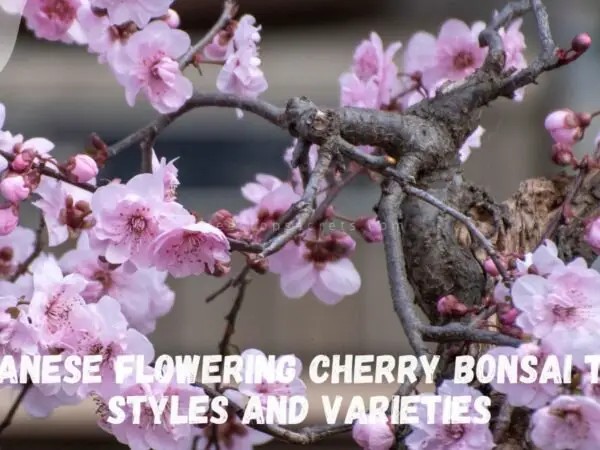Bonsai is the Japanese art of cultivating miniature trees in containers, mimicking the shape and scale of full-sized trees. These miniature trees, known as bonsai, are carefully pruned and shaped to create an aesthetically pleasing representation of nature.
The art of bonsai involves more than just growing a small tree in a pot. It requires patience, care, and an understanding of how trees grow and develop. The practice began centuries ago in Asia and has become popular worldwide for its unique blend of horticulture and art. Bonsai trees are not specific species; instead, various trees, including junipers, maples, and pines, can be used to create bonsai.
Specific Examples:
- Juniper Bonsai: Popular among beginners for its hardiness and ease of shaping.
- Ficus Bonsai: Known for its tolerance to low light and ability to thrive indoors.
- Japanese Maple Bonsai: Appreciated for its beautiful foliage and delicate branching.
Tips for Beginners:
- Choose the Right Species: Start with a hardy species like juniper or ficus that can withstand pruning and less-than-perfect conditions.
- Understand Watering Needs: Bonsai trees require regular watering, but overwatering can lead to root rot. Check the soil daily and water when it feels slightly dry.
- Learn Pruning Techniques: Pruning is essential for maintaining the tree's shape and health. Start with simple cuts and gradually move to more advanced techniques.
- Use Proper Soil: Bonsai soil should be well-draining to prevent waterlogging and root rot. A mix of Akadama, pumice, and lava rock is often recommended.
- Position for Sunlight: Most bonsai trees require at least 4-6 hours of sunlight daily. Place them near a window or outdoors in a suitable location.
Table: Popular Bonsai Tree Species for Beginners
| Tree Species | Light Requirements | Watering Needs | Special Care Tips |
|---|---|---|---|
| Juniper | Full Sun | Keep soil moist but not wet | Protect from frost; prune regularly |
| Ficus | Bright, indirect light | Allow soil to dry slightly between waterings | Indoor-friendly; easy to prune |
| Japanese Maple | Partial shade | Keep soil consistently moist | Protect from strong winds; delicate leaves need care |
| Chinese Elm | Full sun to partial shade | Keep soil moist but well-drained | Responds well to pruning; tolerant of different climates |
| Dwarf Jade | Bright light | Allow soil to dry out between waterings | Tolerant to dry conditions; less frequent watering needed |
Choosing the Right Tree
When I first began, I quickly realized that selecting the appropriate tree species for my local climate was vital. Bonsai trees can be crafted from various types, including junipers, spruces, cedars, pines, Japanese maples, elms, oaks, jade, and snow rose. Each type has its own requirements and suitability based on whether I planned to keep them indoors or outdoors.
| Tree Type | Best For | Indoor/Outdoor |
|---|---|---|
| Juniper | Beginners | Outdoor |
| Japanese Maple | Aesthetic Appeal | Indoor/Outdoor |
| Pine | Hardiness | Outdoor |
| Ficus | Easy Care | Indoor |
| Weeping Fig | Adaptability | Indoor |
Japanese Maple bonsai trees are particularly stunning with their vibrant foliage colors. They require more attention but can thrive in both indoor and outdoor settings. They need dappled sunlight and well-draining soil. Pine bonsai trees are hardy and adaptable, making them excellent choices for beginners. They thrive outdoors, where they can experience seasonal changes necessary for their health and dormancy cycles.
Understanding Outdoor vs. Indoor
It's essential for beginners to understand the differences between outdoor and indoor bonsai trees. Most bonsai trees are not suited for indoor environments; they grow best outdoors to maintain their health and strength. Outdoor trees generally make the best candidates for bonsai, but they do require protection from extreme weather conditions.
Tropical and subtropical bonsai trees, on the other hand, are better suited for indoor environments. These trees do not require a period of dormancy in the winter, unlike temperate trees, which need a decrease in temperature and light intensity that is often not replicated indoors (Bonsai Empire).
By choosing the right tree and understanding its placement, I ensured a solid start to my bonsai journey. This foundational knowledge is key to nurturing these miniature trees successfully.
Popular Beginner Trees
Selecting the right bonsai tree is essential for beginners. I have found that certain species are particularly well-suited for those just starting their bonsai journey. Here are two categories of popular beginner trees: Pine and Japanese Maple, as well as Ficus and Weeping Fig.
Pine and Japanese Maple
Pine Bonsai Trees
Pine bonsai trees are particularly hardy and adaptable, making them great for both beginners and experts. They thrive best in outdoor conditions where they can experience seasonal changes, which are vital for their health and dormancy cycles.
| Feature | Pine Bonsai |
|---|---|
| Hardiness | High |
| Ideal Conditions | Outdoor |
| Seasonal Changes | Required |
| Maintenance Level | Moderate |
Japanese Maple Bonsai Trees
Japanese Maple bonsai trees offer stunning foliage colors and an elegant appearance. Although they require more attention than pine bonsai, they can thrive in both indoor and outdoor settings. They need dappled sunlight and well-draining soil (Martha Stewart).
| Feature | Japanese Maple Bonsai |
|---|---|
| Hardiness | Moderate |
| Ideal Conditions | Indoor/Outdoor |
| Sunlight | Dappled |
| Maintenance Level | High |
Ficus and Weeping Fig
Ficus Bonsai Trees
Ficus bonsai trees are popular among beginners due to their hardiness and ability to tolerate lower light conditions. They feature aerial roots and small leaves, giving them the appearance of a giant tree in miniature (Martha Stewart).
| Feature | Ficus Bonsai |
|---|---|
| Hardiness | High |
| Ideal Conditions | Indoor |
| Sunlight | Lower light tolerance |
| Maintenance Level | Low |
Weeping Fig Bonsai Trees
Weeping fig bonsai trees are another excellent choice for beginners who prefer to keep a bonsai tree indoors. They adapt well to lower light levels and can tolerate inconsistent watering (Martha Stewart).
| Feature | Weeping Fig Bonsai |
|---|---|
| Hardiness | Moderate |
| Ideal Conditions | Indoor |
| Sunlight | Lower light tolerance |
| Maintenance Level | Low |
Choosing the right bonsai tree is a critical step for beginners. By considering these popular options, I am confident that anyone can find a tree that suits their lifestyle and preferences.
Essential Tools for Beginners
To successfully cultivate bonsai trees, having the right tools is essential. As I began my journey into bonsai, I discovered that starting with a few basic tools is crucial before moving on to more advanced equipment.
Basic Tools I Need
For beginners, it is advisable to acquire a few basic tools at first. These tools will help with essential tasks like pruning, styling, and repotting. Here are the basic tools I found necessary:
| Tool | Purpose |
|---|---|
| Pruning Scissors | Cutting shoots and branches |
| Heavy Duty Chinese Shears | Trimming heavier branches |
| Concave Branch Cutters | Creating clean cuts on thicker branches |
| Knob Cutters | Shaping the tree and removing knobs |
| Root Rake/Spatula | Loosening soil and untangling roots |
| Wire Cutters | Cutting wire used for training |
| Pliers | Maneuvering and securing wires |
These tools are crucial for tasks such as cutting shoots, roots, branches, and wires, as well as repotting and styling the bonsai tree (Bonsai Direct).
Advanced Tools for Care
As my experience with bonsai grew, I realized the importance of investing in higher quality tools for more advanced care. These tools help with tasks that require precision and detail. Some advanced tools I found useful include:
| Tool | Purpose |
|---|---|
| Root Cutters | Pruning roots effectively |
| Trunk Splitter | Splitting trunks for shaping |
| Coir Brush | Cleaning the bonsai and maintaining aesthetics |
| Turntable | Rotating the bonsai for even care |
| Rotary Tool | Carving deadwood and creating features |
| Chopstick | Arranging soil and aerating |
| Wound Sealant | Preventing infections on cuts |
These tools are useful for advanced tasks like pruning roots, creating characteristic features, arranging soil, carving deadwood, and preventing infections (Bonsai Direct). Additionally, I recommend a bonsai care handbook for guidance on essential tools and techniques to maintain and style bonsai trees.
Care and Maintenance
Caring for bonsai trees involves a number of essential practices that help maintain their health and appearance. In this section, I will cover watering and fertilizing, as well as pruning techniques.
Watering and Fertilizing
Proper watering is crucial for bonsai trees. Overwatering is one of the biggest mistakes beginners make, leading to root rot and potential death of the tree. I only water my bonsai when the soil starts to dry out about 1 inch below the surface. The frequency of watering varies based on factors such as tree size, soil type, and environmental conditions.
| Condition | Watering Frequency |
|---|---|
| Warm and sunny | Every day to every other day |
| Cool and overcast | Every 3 to 5 days |
| Dormant season (winter) | Every 2 to 4 weeks |
Fertilization is also vital for bonsai trees because they are planted in small pots, where nutrients deplete quickly. I fertilize my bonsai every few weeks during the growing season and reduce the frequency during the dormant period (New England Bonsai Gardens).
| Fertilization Type | Frequency |
|---|---|
| Liquid fertilizer | Every 2 to 4 weeks |
| Granular fertilizer | Every 4 to 6 weeks |
| Dormant season | Less frequently |
Pruning Techniques
Pruning is an essential aspect of bonsai care, used to shape and maintain the tree’s desired form. I utilize several techniques, including pinching, trimming, and wiring, to remove excess growth and encourage branching.
- Pinching: This technique involves using fingers to remove new growth tips, promoting bushier foliage.
- Trimming: I use sharp scissors or pruning shears to cut back longer branches and maintain the tree's shape.
- Wiring: This method involves wrapping wire around branches to guide their growth direction. Care must be taken to avoid damaging the bark.
Regular pruning not only helps maintain the aesthetic appeal of my bonsai but also promotes a healthier tree overall by allowing light and air to reach all parts of the plant. By following these watering, fertilizing, and pruning practices, I ensure that my bonsai trees thrive and continue to flourish.
Common Mistakes to Avoid
When starting my journey with bonsai trees, I quickly learned that avoiding common mistakes is crucial for their health and longevity. Here are two significant pitfalls I encountered and how to steer clear of them.
Overwatering and Overpruning
One of the biggest mistakes I made was overwatering my bonsai trees. Overwatering can lead to root rot, which can ultimately kill the tree. I learned that bonsai should only be watered when the soil begins to dry out about 1 inch below the surface (Basic Bonsai).
| Watering Guidelines | Action |
|---|---|
| Soil Dryness | Check for dryness 1" below the surface |
| Watering Frequency | Water only when needed |
Overpruning is another mistake that can harm the tree. While pruning is essential for shaping and maintaining a healthy bonsai, excessive cutting can stress the tree and inhibit its growth. I found that it’s best to prune gradually and observe how the tree responds over time.
Incorrect Placement and Lighting
Incorrect placement of bonsai trees, especially outdoor varieties like junipers, is a common error. I initially kept my outdoor bonsai trees indoors, which deprived them of the sunlight they needed. Junipers, for example, must be kept outside to thrive (Basic Bonsai).
| Placement Tips | Action |
|---|---|
| Outdoor Bonsai | Keep outside for proper sunlight |
| Indoor Conditions | Use high humidity and artificial lighting for tropical bonsai |
For tropical bonsai trees, I discovered that they should generally be kept outdoors for most of the year. They can be brought indoors during extreme weather, but it's crucial to provide high humidity and sufficient light. Additionally, rotating the bonsai tree every week helps ensure that all foliage receives equal sunlight, promoting balanced growth.
By being mindful of these common mistakes, I was able to cultivate healthier bonsai trees and enhance my skills as a bonsai enthusiast.
Styles and Techniques
Bonsai cultivation is as much about art as it is about horticulture. I have found that mastering certain styles and techniques is essential for shaping and training my bonsai trees. The two primary techniques I focus on are pruning for shape and wiring and training.
Pruning for Shape
Pruning plays a pivotal role in maintaining the health and aesthetics of bonsai trees. I have learned that aesthetic pruning should be done during the dormant period, while regular maintenance pruning is essential year-round to ensure the bonsai tree's health and appearance (Arborist Now).
Pruning is used to shape and maintain the tree’s desired form. Techniques such as pinching, trimming, and selective cutting help remove excess growth, encourage branching, and create the desired aesthetic.
Here’s a simple table outlining the types of pruning techniques:
| Pruning Technique | Purpose |
|---|---|
| Aesthetic Pruning | Shapes the overall look of the tree, usually done in dormancy. |
| Maintenance Pruning | Keeps the tree healthy and manageable year-round. |
| Pinching | Removes new growth to promote branching. |
| Trimming | Shortens branches to maintain shape. |
Wiring and Training
Wiring and training are crucial for shaping the bonsai tree over time. I prefer using aluminum wire for bonsai purposes, as it is easier to apply compared to copper wire (Bonsai Empire). The wiring process involves wrapping the wire around branches to guide their growth direction.
Using wire cutters and pliers is essential for bending the wire into the desired position. It is important to monitor the tree as it grows, as the wire can dig into the bark if left on for too long.
Here’s a quick overview of the wiring process:
| Step | Description |
|---|---|
| 1. Choose Wire | Select aluminum wire for its ease of use. |
| 2. Cut Wire | Measure and cut enough wire for the branch length. |
| 3. Wrap Wire | Gently wrap the wire around the branch, ensuring not to apply too much pressure. |
| 4. Position Branch | Bend the branch into the desired position using the wire. |
| 5. Monitor Growth | Check regularly to ensure the wire does not damage the bark. |
Styling my bonsai involves a combination of these techniques, allowing me to create a visually appealing composition. Regular maintenance tasks such as repotting, pest control, and seasonal care are also important to ensure the overall health and longevity of my bonsai tree (New England Bonsai Gardens).
Final Thoughts: Bonsai Trees for Beginners
Starting your bonsai journey can be incredibly rewarding. With the right knowledge and a bit of patience, you can create beautiful miniature trees that bring a sense of peace and nature into your home. Remember to start with easy-to-care-for species, learn the basics of watering and pruning, and don't be afraid to experiment. Bonsai is not just about growing a tree—it's about cultivating a living piece of art that can provide relaxation and joy for years to come.
FAQs about Bonsai Trees for Beginners
Q: What is the best bonsai tree for beginners?
A: For beginners, the best bonsai trees are those that are hardy and easy to care for, such as the Juniper, Ficus, and Chinese Elm. These species can withstand different conditions and are more forgiving of mistakes, making them ideal for those new to bonsai.
Q: How often should I water my bonsai tree?
A: Watering frequency depends on the tree species, pot size, and environmental conditions. A general rule is to water when the top inch of soil feels dry. Ensure the soil is well-draining to prevent root rot. For most bonsai, this could mean watering every 2-3 days in summer and less frequently in winter.
Q: What type of soil is best for bonsai trees?
A: Bonsai trees thrive in soil that is well-draining yet retains some moisture. A common mix includes Akadama, pumice, and lava rock. This combination allows for adequate drainage while holding enough water to keep the tree hydrated.
Q: Can bonsai trees be grown indoors?
A: Yes, many bonsai species, such as Ficus and Jade, can be grown indoors. These species can tolerate lower light levels and indoor conditions better than others. However, it's essential to provide them with enough indirect sunlight and proper humidity.
Q: How do I prune my bonsai tree?
A: Pruning is crucial for maintaining the shape and health of your bonsai. Use sharp, clean scissors or shears to cut back new growth, focusing on keeping the tree balanced and encouraging bushier growth. Start with minor cuts, and as you gain confidence, move to more advanced shaping techniques.
Q: What are common mistakes beginners make with bonsai trees?
A: Some common mistakes include overwatering, using the wrong soil type, placing the tree in insufficient light, and not pruning correctly. Overwatering can lead to root rot, while poor soil can hinder growth. It's important to research and understand the specific needs of your bonsai species.
Image Source: Paid image from CANVA

